- Joined
- Feb 21, 2024
- Messages
- 92
We first set foot on the trail to begin this trip on August 3rd, but the origins of it dated back to early April. It was at that point that I talked four of my oldest friends and hiking buddies into joining me in the northwest corner of Yellowstone National Park as I'd pulled a permit that synched the Crescent/High Lake loop in with a trip over to Sportsman Lake, down Fan Creek, and out the Gallatin River back to US-191.
Flights were booked. Plans were made. Plans unraveled quickly.
A torn rotator cuff sent one of our party to the sidelines indefinitely in June. Another member - a real estate agent - realized quickly he'd need to be much busier during this window than originally planned, and had to bail on most of the trip. Smoke from Idaho, Oregon, and Montana enveloped the northern portion of the park, and campsite WB1 - where we were set to stay on our final night of the trip - had been restricted due to bear activity for two weeks as our go-day neared. Fire restrictions predictably came down, and the trip we'd mapped out in great detail looked more and more like a no-go by the end of July.
I've got a 3 year old and 15 month old, and this was my one full week of 2024 where I could 100% get out and do some good trekking. Thankfully, the two other members of this trip that had booked flights into Jackson for the original Yellowstone trip were amenable to some trip malleability, and they mercifully agreed to join me further south in the Winds instead of up north in Yellowstone where the air quality was much, much worse.
We settled on a loop out of Green River Lakes that would eventually return us to the car via Porcupine Pass and Porcupine Creek on day five, though the precise route we took to get there was TBD as we set out on the 3rd.
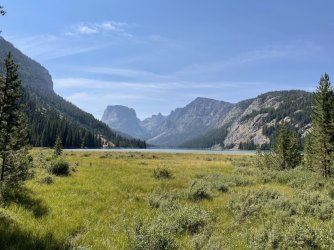
Squaretop Mountain & Co. at Lower Green River Lake
It touched 95 degrees in Jackson on the afternoon of the 3rd, the same afternoon we set out on Day 1 of our trek. We headed south with eyes on camp as far away as Three Forks Park, though we were carrying enough fishing gear to make periodic stops on the Green River when it looked appropriate. Ultimately, Day 1 was not just a mileage day while the trail was mostly flat, it was a barometer day to determine just what we'd make out of the trip as a whole. If we stopped to fish and covered less ground, we'd end up heading west early past Clark Lake and Lozier Lakes to get back towards Porcupine Pass. If we hoofed it further down the Green on the CDT, that would give us the opportunity to target Summit Lake for Day 2 and a deeper route including No Name Lakes, Cutthroat Lake, and Palmer Canyon.
The heat on Day 1 didn't get to us too badly as the Highline Trail/CDT was mostly in the trees. As a result, we made good time early, though by the time we reached Beaver Park (on a Saturday afternoon) it became clear that this basin was going to busy for the night. Overnighters, south-to-north CDT hikers, and fisherfolks with poles were at most every good campsite we came across, and that paired with the persistent optimism of Day 1 of a long-planned trip kept us pushing further on the trail. We settled in finally around 6 PM in the trees at the northern edge of Three Forks Park, and did so with some fishing on the fast rapids of the Green on our mind.
We caught a few small, but fierce brookies and hit the hay.
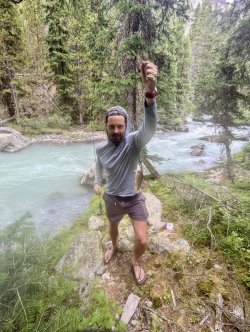
Small brownie near the headwaters of the Green River
Day 2 was always going to be a climbing day. The switchbacks came early and often immediately after we got warm cruising past the meadows of Three Forks Park, and it became clear that we'd rather bypass heading west to Clark Lake and press on down the Highline Trail over Green River Pass and on to Summit Lake where we'd set up camp for night 2.
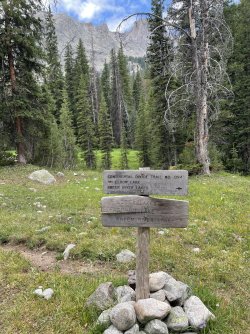
After the switchbacks drove us up over 1,000 feet in a hurry, the trail mellowed for a bit as it followed Trail Creek south towards Green River Pass. After having spent all of Day 1 in the trees and much of the morning of Day 2 switchbacking, it was nice to finally get into a more sub-alpine terrain where the pines were more sparse and the views began to emerge. Thankfully, the heat that had hounded us on Day 1 had subsided significantly, and the kind of weather you'd more expect from the Winds in early August swept in - clouds, highs around 70 as we gained elevation, and the persistent chance of thunderstorms as the afternoon neared.
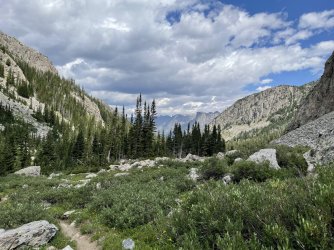
Looking north from whence we came as we neared Green River Pass
Green River Pass is something of a rolling pass, with lush, tumbling meadows strewn with giant boulders. While rather narrow as you begin the gradual climb up, it opens up into a wider valley as you pass 10,000 feet, and the scene looks straight out of the Scottish Highlands - especially when gray clouds and cool air set its stage. Summit Lake, aptly named as it sits squarely in the meadows of the pass, is flanked by the ragged Glover Peak (12,068 feet) to its west, a typical Winds mountain in that its rocky spires look like they were hand molded by bear claws.
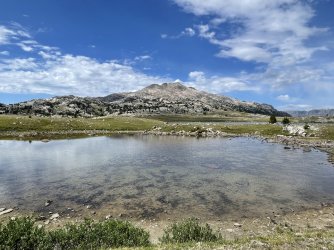
Glover Peak to the northwest of Summit Lake, with a small glacial pond in the foreground
We set up camp a couple hundred yards off the southern shore of the lake, finding a nice grove of pines for some wind protection as a looming storm grew closer. After some light rain and a pair of thunder rumbles, the rest of the afternoon actually cleared up and turned in to the nicest weather we'd see all trip - sunny skies, moderate winds, temperature somewhere around 70. We gave fishing the lake a whirl, but had no success, guessing that the heat of the previous few days had driven what fish there were that high to the portions of the lake that were deeper than our gear could reach.
We retreated back to camp from the shores of the lake in late afternoon, and it became evident that the clouds were going to clear out and give us our best chance at seeing the full realm of a starry, wilderness sky.

Sunset at Summit Lake

Camp just south of Summit Lake
After sweating through the first night of the trip, the cooler weather and higher elevation made for a chilly second evening. I brought a Mountain Hardwear 20 degree bag on this trip, but I've had it for nearly a decade and put over a hundred nights of use into it and it's decidedly no longer 20 degree rated. Let's just say I was comfortable, but quite glad the temperature didn't dip any colder than it did.
Day 3 evolved into our excuse to put to use the fishing gear we'd hauled all the way in for this trip. While we'd managed to cast some lines in the Green on the evening of Day 1, our plan on Day 3 was to set out early and skirt No Name Lake, fish Cutthroat Lake, and potentially fish Palmer Lake as we worked our way west on the Doubletop Mountain Trail. We'd eventually drop down into Palmer Canyon to the headwaters of the New Fork River to meet up with the fourth member of our party who was set to hike in that day from New Fork Lakes if all went to plan, which it decidedly did not.

Quick snack at lower No Name Lake
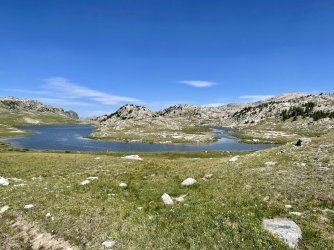
The horseshoe bend on upper No Name Lake
A quick and beautiful couple hundred feet of pop greets you as you turn west from Summit Lake along the Doubletop Mountain Trail, and the copious water sources are around every single turn. Our original intention was to fish Cutthroat Lake when we got there, but we were tempted by the dozen or so lakes, ponds, and streams we crossed en route as the sun sat high in the sky with little wind. Funny, it was precisely along that route when the wind laid down the most yet the Winds (eponymous) felt the most alive.
We reached Cutthroat Lake at what was the perfect time for lunch, and after a tortilla full of Genoa salami and what remained of my hard cheddar it was time to cast some lines. An hour and a half later, we'd caught cutties on everything - dry flies, hoppers, droppers, spoons, what have you. Were it not for a 2,000 foot drop into Palmer Canyon left on our plate that day and an updated weather forecast calling for storms that afternoon, I believe we'd still be there to this day.

Cutthroat trout at Cutthroat Lake, right after he flipped off the hook - (I released him immediately thereafter)
It was at this moment that our fishing success struck a deeper, more personal note. 25 years ago this summer my dad took high-school me on a horseback camp trip into Yellowstone out of southern Montana, a ride-in that took us past Electric Peak en route to Sportsman Lake. My dad's nearing 80 years old at the moment and, in theory, has put prostate cancer in his rearview mirror, but doing trips like that (or this) are no longer in his wheelhouse. We caught more trout in our 3 days at Sportsman Lake that summer than I may have caught combined over the subsequent portion of my life, and the original trip I planned (that we cancelled last minute) was very much an homage to that original one. I was going to go back to Sportsman and try to catch a ton of fish, and opted to bail on that last minute for this trip instead. So, for the fishing expedition that was supposed to be an homage to have such success elsewhere in such dream conditions got a hat-tip to the karma gods from me.
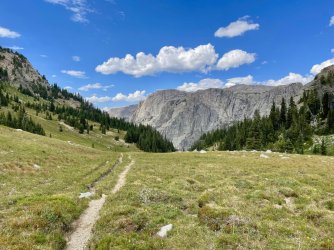
The steep walls of Palmer Canyon as we turned north on the Palmer Lake Trail towards the headwaters of the New Fork River.
Thompson Lakes and the appropriately named Hidden Lakes hide behind the steep, sheer walls of Palmer Canyon's northside. The face itself drops well over 2,000 feet to the watershed below, one of three creeks that flow into confluence at the headwaters of the New Fork River. We knew we, too, would be shedding over 2,000 feet to drop down to our next camp, but from the perspective of the map (and map only) it appeared to be a pretty straightforward drop. Turns out that trail - after some skree-like switchbacks up top - effectively follows the creekbed of an annual snowmelt run, and the wood debris from presumably this season's runoff turned said watershed into a route-finding obstacle course down a high-walled, steep creek.
Then came the thunder. We felt relatively safe because a) we were descending elevation rapidly and b) were in something of a canyon, not a high point, but at first rumble we were actually wading shin-deep through the creek itself because that was the path of least resistence. We'd lost the trail completely roughly a mile from the junction of our creek and Dodge Creek (and the New Fork headwaters), and while we were descending and seeking cover it was still a little hard to disassociate 'fear of lightning' and 'standing in water' while being somewhat lost.
Lost, of course, was relative. We were in the right watershed en route to the first junction, but the trail - which we later found about 50 feet above us on a ledge - was nowhere to be found at the precise time we needed to cover ground quickly. As a result, we were still un-camped when the skies opened, and we followed our first instincts to climb out of the creek and seek shelter under a grove of pines as the thunder, lightning, and pouring rain unleashed.
After an hour of hunkering down, things calmed for a bit - just long enough for me to hike up the ridge to our right and find a nice, tidy trail that had been over our shoulder all along. We rejoined it, hiked less than 20 minutes, and found a somewhat protected camp at the junction of the Palmer Lake Trail and New Fork Trail, the latter of which we'd take up and over Porcupine Pass the next day.
It rained as we cooked dinner. It rained too hard to get a fire going. It rained much too hard to dry anything out, and we probably got more things wet just by trying. Then, it rained all night - and got just as cold as the previous night.
(Thanks to a late ping on our messenger, we also learned our real estate agent friend wasn't able to hike in and meet us that day and would instead be meeting us on the other side of Porcupine Pass the next day. I truly hope he was just busy, but I wouldn't fault him if I find out down the road that he just merely watched the weather forecast.)
We slept until almost 7:45 AM on the morning of Day 4. It was wet and cold. Our shoes were wet and cold. The agenda for the day included an almost immediate climb up from our camp at ~8,800 feet, with Porcupine Pass some 2,000 feet higher the destination, and we'd be doing so wet.
And cold.
As the sun finally peeked over the lip of Palmer Canyon to the southeast, we were relieved to see blue skies along with it - knowing that while the quick climb in wet everything would be an annoyance, the moment we began to near treeline we'd have the kind of sunshine we'd need to dry out our world.

The start of the climb up Porcupine Pass
Morale for this trip, I should point out, was generally awesome. Old friends, great fishing, Milky Way skies, and a trip devoid of the smoke and haze we'd seen both in Jackson and to the north. The end of Day 3 dealt us a tough hand, though, with wet, cold, aches, and the reality of being 40 and having logged some 30 miles of alpine and sub-alpine backpacking all rearing their heads at once. The morning of Day 4 could have been a low point, but as we walked off our morning aches and found a high meadow blanketed in sunshine, wildflowers, and a light breeze, any attempt to derail the Type II fun we'd logged all trip went immediately by the wayside.
We could see the last high point of the trip. We knew how good the fishing was on Porcupine Creek, and that our buddy would be meeting us down there with better angling acumen than we had (and a bottle of much needed fresh whiskey). We hadn't made it, just yet, but we'd made it to the point where it was all downhill from here, and I'm here to make the argument that's an even more direct shot of dopamine.
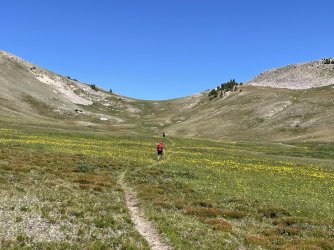
The final push up to Porcupine Pass (10,872 feet)
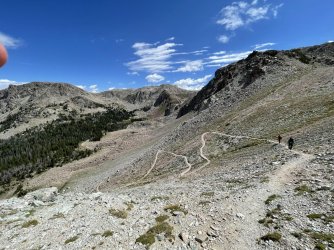
Descent of Porcupine Pass on the northside, complete with resident idiot's finger in the picture
Porcupine Pass features a steep section of switchbacks on its northside, the kind I'd opt out of ascending at all costs. The descent, though, paired with the optimism of where we were in our trip made it feel like an escalator to the fun stuff, and that's precisely how it panned out. We motored north once we put the switchbacks behind us, and the numerous parks along Porcupine Creek opened up into prime fishing and camping ground. When we finally made it to roughly 7 miles from our eventual exit point back at Green River Lakes, we found home under Battleship Mountain (11,584 feet) along a fishy-looking bend in the creek.
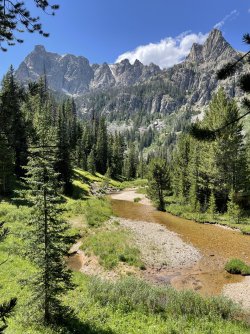
Porcupine Creek under Battleship Mountain
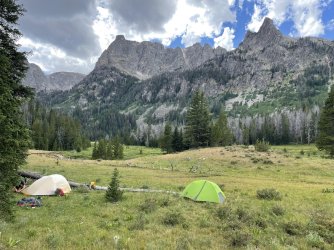
Storms building over camp under Battleship Mountain
The skies began to get darker, and we quickly realized it would behoove us to get our tents set up. We had a hammock in the trio, so we searched diligently for a spot where he'd have two trees appropriately distanced from one another in an area where the others of us could set up our tents. Close proximity was something of a priority that night since I'd seen a black bear on the opposite ridge of the Porcupine Creek drainage and there was bear scat all up and down the trail down to where we camped.
Not three minutes after we got our sleeping arrangements set up, our fourth came bounding up the trail from the north with a smile on his face as big as the whiskey bottle in his pack. Good thing, too - as he rushed to get his tent set up, the storms turned ugly, and we retreated to the shelter of the hammock's tarp in the trees as we watched lightning and heard thunder tumble down the drainage.
The whiskey retreated to the shelter with us. Storms and all, it was a high point of the trip.
Sometime around 7:30 PM, the rain broke and the creek called us back into action. The brookies in that section were small, but hungry, and their feeding frenzy was to our delight. We managed to find a keeper apiece and cooked them up on a makeshift fire as the sun went down, the perfect way to wrap our final evening in the Winds.
Day 5? Let's just say we knew it was a 7 mile hustle downhill with packs much ligher than five days prior, with burgers at The Bird back in Jackson the next priority. We could see early on that smoke had found its way to the Green River Lakes basin, and waiting around there for any longer was going to bring that ugly variable into the equation. As a result, we pushed hard for an hour and 45 minutes quickly back to the car, and called time on a trip that'll resonate within me for the rest of my time.
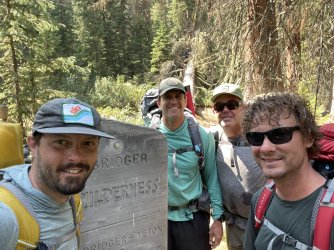
Those involved.
The Garmin/Strava tracking of our bunch pegged the trip at roughly 46 miles and some 7,500 feet of ascent. That was about 8 miles further (and 3,000 feet more climbing) than the originally scheduled Yellowstone trip, but we all managed to make it out relatively unscathed.
I would not recommend this trip to anyone. It was terrible, we had zero fun, do not attempt it, and most certainly make sure you leave it all alone for a certain idiot in a SKI Cola hat to have at his own discretion whenever he may choose. Those are the wishes of said author, unless you vow to include him in your journey, too.
Flights were booked. Plans were made. Plans unraveled quickly.
A torn rotator cuff sent one of our party to the sidelines indefinitely in June. Another member - a real estate agent - realized quickly he'd need to be much busier during this window than originally planned, and had to bail on most of the trip. Smoke from Idaho, Oregon, and Montana enveloped the northern portion of the park, and campsite WB1 - where we were set to stay on our final night of the trip - had been restricted due to bear activity for two weeks as our go-day neared. Fire restrictions predictably came down, and the trip we'd mapped out in great detail looked more and more like a no-go by the end of July.
I've got a 3 year old and 15 month old, and this was my one full week of 2024 where I could 100% get out and do some good trekking. Thankfully, the two other members of this trip that had booked flights into Jackson for the original Yellowstone trip were amenable to some trip malleability, and they mercifully agreed to join me further south in the Winds instead of up north in Yellowstone where the air quality was much, much worse.
We settled on a loop out of Green River Lakes that would eventually return us to the car via Porcupine Pass and Porcupine Creek on day five, though the precise route we took to get there was TBD as we set out on the 3rd.

Squaretop Mountain & Co. at Lower Green River Lake
It touched 95 degrees in Jackson on the afternoon of the 3rd, the same afternoon we set out on Day 1 of our trek. We headed south with eyes on camp as far away as Three Forks Park, though we were carrying enough fishing gear to make periodic stops on the Green River when it looked appropriate. Ultimately, Day 1 was not just a mileage day while the trail was mostly flat, it was a barometer day to determine just what we'd make out of the trip as a whole. If we stopped to fish and covered less ground, we'd end up heading west early past Clark Lake and Lozier Lakes to get back towards Porcupine Pass. If we hoofed it further down the Green on the CDT, that would give us the opportunity to target Summit Lake for Day 2 and a deeper route including No Name Lakes, Cutthroat Lake, and Palmer Canyon.
The heat on Day 1 didn't get to us too badly as the Highline Trail/CDT was mostly in the trees. As a result, we made good time early, though by the time we reached Beaver Park (on a Saturday afternoon) it became clear that this basin was going to busy for the night. Overnighters, south-to-north CDT hikers, and fisherfolks with poles were at most every good campsite we came across, and that paired with the persistent optimism of Day 1 of a long-planned trip kept us pushing further on the trail. We settled in finally around 6 PM in the trees at the northern edge of Three Forks Park, and did so with some fishing on the fast rapids of the Green on our mind.
We caught a few small, but fierce brookies and hit the hay.

Small brownie near the headwaters of the Green River
Day 2 was always going to be a climbing day. The switchbacks came early and often immediately after we got warm cruising past the meadows of Three Forks Park, and it became clear that we'd rather bypass heading west to Clark Lake and press on down the Highline Trail over Green River Pass and on to Summit Lake where we'd set up camp for night 2.

After the switchbacks drove us up over 1,000 feet in a hurry, the trail mellowed for a bit as it followed Trail Creek south towards Green River Pass. After having spent all of Day 1 in the trees and much of the morning of Day 2 switchbacking, it was nice to finally get into a more sub-alpine terrain where the pines were more sparse and the views began to emerge. Thankfully, the heat that had hounded us on Day 1 had subsided significantly, and the kind of weather you'd more expect from the Winds in early August swept in - clouds, highs around 70 as we gained elevation, and the persistent chance of thunderstorms as the afternoon neared.

Looking north from whence we came as we neared Green River Pass
Green River Pass is something of a rolling pass, with lush, tumbling meadows strewn with giant boulders. While rather narrow as you begin the gradual climb up, it opens up into a wider valley as you pass 10,000 feet, and the scene looks straight out of the Scottish Highlands - especially when gray clouds and cool air set its stage. Summit Lake, aptly named as it sits squarely in the meadows of the pass, is flanked by the ragged Glover Peak (12,068 feet) to its west, a typical Winds mountain in that its rocky spires look like they were hand molded by bear claws.

Glover Peak to the northwest of Summit Lake, with a small glacial pond in the foreground
We set up camp a couple hundred yards off the southern shore of the lake, finding a nice grove of pines for some wind protection as a looming storm grew closer. After some light rain and a pair of thunder rumbles, the rest of the afternoon actually cleared up and turned in to the nicest weather we'd see all trip - sunny skies, moderate winds, temperature somewhere around 70. We gave fishing the lake a whirl, but had no success, guessing that the heat of the previous few days had driven what fish there were that high to the portions of the lake that were deeper than our gear could reach.
We retreated back to camp from the shores of the lake in late afternoon, and it became evident that the clouds were going to clear out and give us our best chance at seeing the full realm of a starry, wilderness sky.

Sunset at Summit Lake

Camp just south of Summit Lake
After sweating through the first night of the trip, the cooler weather and higher elevation made for a chilly second evening. I brought a Mountain Hardwear 20 degree bag on this trip, but I've had it for nearly a decade and put over a hundred nights of use into it and it's decidedly no longer 20 degree rated. Let's just say I was comfortable, but quite glad the temperature didn't dip any colder than it did.
Day 3 evolved into our excuse to put to use the fishing gear we'd hauled all the way in for this trip. While we'd managed to cast some lines in the Green on the evening of Day 1, our plan on Day 3 was to set out early and skirt No Name Lake, fish Cutthroat Lake, and potentially fish Palmer Lake as we worked our way west on the Doubletop Mountain Trail. We'd eventually drop down into Palmer Canyon to the headwaters of the New Fork River to meet up with the fourth member of our party who was set to hike in that day from New Fork Lakes if all went to plan, which it decidedly did not.

Quick snack at lower No Name Lake

The horseshoe bend on upper No Name Lake
A quick and beautiful couple hundred feet of pop greets you as you turn west from Summit Lake along the Doubletop Mountain Trail, and the copious water sources are around every single turn. Our original intention was to fish Cutthroat Lake when we got there, but we were tempted by the dozen or so lakes, ponds, and streams we crossed en route as the sun sat high in the sky with little wind. Funny, it was precisely along that route when the wind laid down the most yet the Winds (eponymous) felt the most alive.
We reached Cutthroat Lake at what was the perfect time for lunch, and after a tortilla full of Genoa salami and what remained of my hard cheddar it was time to cast some lines. An hour and a half later, we'd caught cutties on everything - dry flies, hoppers, droppers, spoons, what have you. Were it not for a 2,000 foot drop into Palmer Canyon left on our plate that day and an updated weather forecast calling for storms that afternoon, I believe we'd still be there to this day.

Cutthroat trout at Cutthroat Lake, right after he flipped off the hook - (I released him immediately thereafter)
It was at this moment that our fishing success struck a deeper, more personal note. 25 years ago this summer my dad took high-school me on a horseback camp trip into Yellowstone out of southern Montana, a ride-in that took us past Electric Peak en route to Sportsman Lake. My dad's nearing 80 years old at the moment and, in theory, has put prostate cancer in his rearview mirror, but doing trips like that (or this) are no longer in his wheelhouse. We caught more trout in our 3 days at Sportsman Lake that summer than I may have caught combined over the subsequent portion of my life, and the original trip I planned (that we cancelled last minute) was very much an homage to that original one. I was going to go back to Sportsman and try to catch a ton of fish, and opted to bail on that last minute for this trip instead. So, for the fishing expedition that was supposed to be an homage to have such success elsewhere in such dream conditions got a hat-tip to the karma gods from me.

The steep walls of Palmer Canyon as we turned north on the Palmer Lake Trail towards the headwaters of the New Fork River.
Thompson Lakes and the appropriately named Hidden Lakes hide behind the steep, sheer walls of Palmer Canyon's northside. The face itself drops well over 2,000 feet to the watershed below, one of three creeks that flow into confluence at the headwaters of the New Fork River. We knew we, too, would be shedding over 2,000 feet to drop down to our next camp, but from the perspective of the map (and map only) it appeared to be a pretty straightforward drop. Turns out that trail - after some skree-like switchbacks up top - effectively follows the creekbed of an annual snowmelt run, and the wood debris from presumably this season's runoff turned said watershed into a route-finding obstacle course down a high-walled, steep creek.
Then came the thunder. We felt relatively safe because a) we were descending elevation rapidly and b) were in something of a canyon, not a high point, but at first rumble we were actually wading shin-deep through the creek itself because that was the path of least resistence. We'd lost the trail completely roughly a mile from the junction of our creek and Dodge Creek (and the New Fork headwaters), and while we were descending and seeking cover it was still a little hard to disassociate 'fear of lightning' and 'standing in water' while being somewhat lost.
Lost, of course, was relative. We were in the right watershed en route to the first junction, but the trail - which we later found about 50 feet above us on a ledge - was nowhere to be found at the precise time we needed to cover ground quickly. As a result, we were still un-camped when the skies opened, and we followed our first instincts to climb out of the creek and seek shelter under a grove of pines as the thunder, lightning, and pouring rain unleashed.
After an hour of hunkering down, things calmed for a bit - just long enough for me to hike up the ridge to our right and find a nice, tidy trail that had been over our shoulder all along. We rejoined it, hiked less than 20 minutes, and found a somewhat protected camp at the junction of the Palmer Lake Trail and New Fork Trail, the latter of which we'd take up and over Porcupine Pass the next day.
It rained as we cooked dinner. It rained too hard to get a fire going. It rained much too hard to dry anything out, and we probably got more things wet just by trying. Then, it rained all night - and got just as cold as the previous night.
(Thanks to a late ping on our messenger, we also learned our real estate agent friend wasn't able to hike in and meet us that day and would instead be meeting us on the other side of Porcupine Pass the next day. I truly hope he was just busy, but I wouldn't fault him if I find out down the road that he just merely watched the weather forecast.)
We slept until almost 7:45 AM on the morning of Day 4. It was wet and cold. Our shoes were wet and cold. The agenda for the day included an almost immediate climb up from our camp at ~8,800 feet, with Porcupine Pass some 2,000 feet higher the destination, and we'd be doing so wet.
And cold.
As the sun finally peeked over the lip of Palmer Canyon to the southeast, we were relieved to see blue skies along with it - knowing that while the quick climb in wet everything would be an annoyance, the moment we began to near treeline we'd have the kind of sunshine we'd need to dry out our world.

The start of the climb up Porcupine Pass
Morale for this trip, I should point out, was generally awesome. Old friends, great fishing, Milky Way skies, and a trip devoid of the smoke and haze we'd seen both in Jackson and to the north. The end of Day 3 dealt us a tough hand, though, with wet, cold, aches, and the reality of being 40 and having logged some 30 miles of alpine and sub-alpine backpacking all rearing their heads at once. The morning of Day 4 could have been a low point, but as we walked off our morning aches and found a high meadow blanketed in sunshine, wildflowers, and a light breeze, any attempt to derail the Type II fun we'd logged all trip went immediately by the wayside.
We could see the last high point of the trip. We knew how good the fishing was on Porcupine Creek, and that our buddy would be meeting us down there with better angling acumen than we had (and a bottle of much needed fresh whiskey). We hadn't made it, just yet, but we'd made it to the point where it was all downhill from here, and I'm here to make the argument that's an even more direct shot of dopamine.

The final push up to Porcupine Pass (10,872 feet)

Descent of Porcupine Pass on the northside, complete with resident idiot's finger in the picture
Porcupine Pass features a steep section of switchbacks on its northside, the kind I'd opt out of ascending at all costs. The descent, though, paired with the optimism of where we were in our trip made it feel like an escalator to the fun stuff, and that's precisely how it panned out. We motored north once we put the switchbacks behind us, and the numerous parks along Porcupine Creek opened up into prime fishing and camping ground. When we finally made it to roughly 7 miles from our eventual exit point back at Green River Lakes, we found home under Battleship Mountain (11,584 feet) along a fishy-looking bend in the creek.

Porcupine Creek under Battleship Mountain

Storms building over camp under Battleship Mountain
The skies began to get darker, and we quickly realized it would behoove us to get our tents set up. We had a hammock in the trio, so we searched diligently for a spot where he'd have two trees appropriately distanced from one another in an area where the others of us could set up our tents. Close proximity was something of a priority that night since I'd seen a black bear on the opposite ridge of the Porcupine Creek drainage and there was bear scat all up and down the trail down to where we camped.
Not three minutes after we got our sleeping arrangements set up, our fourth came bounding up the trail from the north with a smile on his face as big as the whiskey bottle in his pack. Good thing, too - as he rushed to get his tent set up, the storms turned ugly, and we retreated to the shelter of the hammock's tarp in the trees as we watched lightning and heard thunder tumble down the drainage.
The whiskey retreated to the shelter with us. Storms and all, it was a high point of the trip.
Sometime around 7:30 PM, the rain broke and the creek called us back into action. The brookies in that section were small, but hungry, and their feeding frenzy was to our delight. We managed to find a keeper apiece and cooked them up on a makeshift fire as the sun went down, the perfect way to wrap our final evening in the Winds.
Day 5? Let's just say we knew it was a 7 mile hustle downhill with packs much ligher than five days prior, with burgers at The Bird back in Jackson the next priority. We could see early on that smoke had found its way to the Green River Lakes basin, and waiting around there for any longer was going to bring that ugly variable into the equation. As a result, we pushed hard for an hour and 45 minutes quickly back to the car, and called time on a trip that'll resonate within me for the rest of my time.

Those involved.
The Garmin/Strava tracking of our bunch pegged the trip at roughly 46 miles and some 7,500 feet of ascent. That was about 8 miles further (and 3,000 feet more climbing) than the originally scheduled Yellowstone trip, but we all managed to make it out relatively unscathed.
I would not recommend this trip to anyone. It was terrible, we had zero fun, do not attempt it, and most certainly make sure you leave it all alone for a certain idiot in a SKI Cola hat to have at his own discretion whenever he may choose. Those are the wishes of said author, unless you vow to include him in your journey, too.
Last edited:
